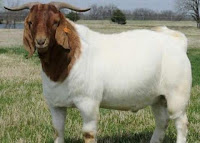The Law of Eating Goat Testicles
Assalamu 'alaikum wr. wb. I want to ask about the legal status of goat testicles. Because, before Eid al-Adha, which was circulating in several WA groups, posts were pictures of parts of sacrificial animals that were forbidden to eat. One of them is the testes. I thank you for the explanation. Wassalamu 'alaikum wr. wb. (Name withheld / Bekasi)
Assalamu's answer 'alaikum wr. wb. Dear questioner, may Allah SWT always be blessed.
As we all know, goats are animals that can be slaughtered and the meat is halal. But the halal slaughter of goats with notes, for example how to slaughter them must be with the provisions that have been regulated by syara`. Up to this point, there are no significant problems. But then it turned out that the problem was found, are all the results of the goat slaughter allowed to be eaten or not, such as the testicles? In this context, the views of the jurisprudence scholars were divided. According to the opinion of scholars from the Hanafi school of thought, there are at least seven parts that are prohibited from eating halal animals such as goats, namely flowing blood, genitalia, two testes, female genitalia, ghuddah, urine and gall bladder.
ما يحرم أكله من أجزاء الحيوان المأكول سبعة: الدم المسفوح والذكر والأنثيان والقبل والغدة والمثانة والمرارة
means, "Something that is forbidden to eat from the limbs of animals that may be eaten seven, the blood flowing, genitals, two testicles, pubic female goat , ghuddah, urine (bladder), and gall bladder, "(See Ibn Abidin, Hasyiyatu Raddil Mukhtar, Beirut, Darul Fikr, 1421 H / 2000 AD, juz VI, page 311).
قوله والغدة) بضم الغين المعجمة كل عقدة في الجسد أطاف بها شحم, وكل قطعة صلبة بين العصب ولا تكون في البطن كما في القاموس
means, "remarks (author); al-ghuddah, with its ghain letter dhammah diharakati, the meaning is any lump that grows in the body which is covered with fat or any hard part that is between the veins and not in the stomach. This is according to the information contained in the book Al-Qamus (by Fairuz Abadi, pent), "(See Ibn Abidin, Hasyiyatu Raddil Mukhtar, Beirut, Darul Fikr, 1421 H / 2000 AD, juz VI, page 749).
The prohibition of the seven parts of the animal's body that can be eaten is based on a hadith narrated by Mujahid which states that the Prophet Muhammad did not like the genitals of goats, two testes, genitals, ghuddah, bladder, urinary bladder, and blood. According to Al-Kasani, Rasulullah SAW's dislike in this context means makruh tahrim. The logic that is built to arrive at the conclusion of makruh tahrim is that in the hadith it collects six things (namely the genitals, two testes, genitals, ghuddah, bladder and bladder) with blood in dislike (fil karahah), while the blood that flows itself is forbidden. وروي عن مجاهد رضي الله عنه أنه قال: كره رسول الله صلى الله عليه وسلم من الشاة الذكر والأنثيين والقبل والغدة والمرارة والمثانة والدم فالمراد منه كراهة التحريم بدليل أنه جمع بين الأشياء الستة وبين الدم في الكراهة, والدم المسفوح محرم
means, "narrated from Mujahid RA that he said, Rasulullah dislikes (kariha) the genitals of a goat, two testes, a goat's genitals (female), ghuddah, gall bladder, bladder, and blood. What is meant by disliking in this context is makruh tahrim. There is a tendency to understand makruh here as makruh tahrim because the accumulation of six things with blood in the hadith, while the blood that flows is haram, "(See 'Alauddin Al-Kasani, Bada'ius Shana'i fi Tartibis Syara'i , Beirut, Darul Kitab Al-'Arabi, 1982 AD, juz V, page 61). However, according to the information contained in the book Al-Majmu 'Syarhul Muhadzdzab written by Muhyiddin Syarf An-Nawawi, the hadith narrated by Mujahid above is considered a weak hadith. The consequence is that the hadith cannot be used as a legal basis. Furthermore, he put forward Al-Khaththabi's view which states that it is in accordance with ijma 'or the consensus of the scholars that blood is haram. Meanwhile, the six things that are mentioned along with blood are haraam, not haraam. This is what we understand in the following statement:
فصل) عن مجاهد قال (كان رسول الله صلى الله عليه وسلم يكره من الشاة سبعا الدم والمرار والذكر والانثيين والحيا والغدة والمثانة وكان أعجب الشاة إليه مقدمها) رواه البيهقى هكذا مرسلا وهو ضعيف قال وروى موصولا بذكر ابن عباس وهو حديث قال ولا يصح وصله قال الخطابى اَلدَّمُ حَرَامٌ بِالْاِجْمَاعِ وَعَامَّةُ الْمَذْكُورَاتِ مَعَهُ مَكْرُوهَةٌ غَيْرُ مُحَرَّمَةٌ
Meaning, "he is a goat, that is blood, messengers, is the genitals of a And the parts of the goat that the Prophet liked the most were cubits and shoulders'. Thus this hadith was narrated by Al-Baihaqi mursal and it was categorized as dha'if hadith. Al-Baihaqi said, there are also those who are narrated maushul (continuous sanadnya or muttashil) by mentioning Ibn Abbas RA which is a hadith ... but unfortunately this continuity cannot be accepted. Al-Khaththabi argues that blood is haram in accordance with the ijma 'of the scholars, while everything that is mentioned with blood in the hadith is insulted not haraam. " Similar to Al-Khaththabi's view is the history of Ibn Habib from the Maliki school of thought, which states that animal testicles that are lawful to eat are not punished as haram. This is as understood in the information contained in the book At-Taj wal Iklil as follows:
وَرَوَى ابْنُ حَبِيبٍ اسْتِثْقَالَ أَكْلِ عَشْرَةٍ دُونَ تَحْرِيمِ الْأُنْثَديانِ وََ
animal bodies that are lawful) but not prohibited, namely two testes, genitals, ghuddah ... ”From the explanation we have presented, there are at least two views regarding the law of goat testicles. First, declaring haram as stated by scholars from the Hanafi school of thought. Meanwhile, the second opinion states that it is not haram, as stated by Al-Khaththabi scholars from the Syafi'i school and Ibn Habib's narration from the Maliki school of thought.
Source: https://islam.nu.or.id/


0 Response to "The Law of Eating Goat Testicles"
Post a Comment